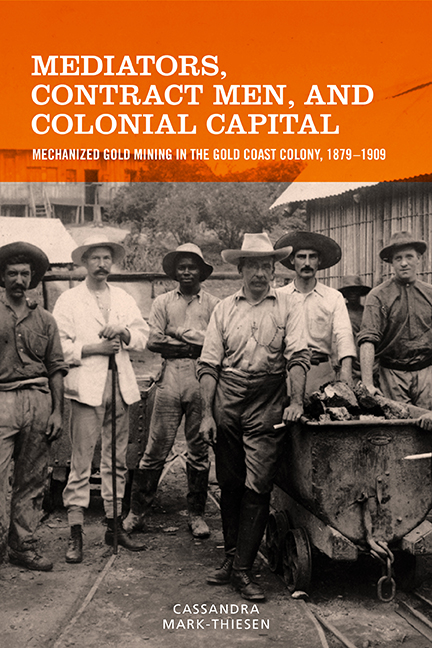 Mediators, Contract Men, and Colonial Capital
Mediators, Contract Men, and Colonial Capital Book contents
- Frontmatter
- Dedication
- Contents
- List of Illustrations
- Acknowledgments
- Introduction
- 1 Prospectors, Politicians, and the Question of “Progress”: The First and Second Gold Booms in Wassa
- 2 Labor Recruitment in the Nineteenth Century: The Place of Practicality
- 3 Disrupted Recruitment at the Turn of the Twentieth Century: Women, Whites, and Other Labor Agents
- 4 Government Strategies for Assisting the Mines
- 5 Labor Agents, Chiefs and Officials, 1905–1909: The Incorporation of the Northern Territories’ Labor Reserve
- Conclusion
- Notes
- Bibliography
- Index
4 - Government Strategies for Assisting the Mines
Published online by Cambridge University Press: 29 May 2021
- Frontmatter
- Dedication
- Contents
- List of Illustrations
- Acknowledgments
- Introduction
- 1 Prospectors, Politicians, and the Question of “Progress”: The First and Second Gold Booms in Wassa
- 2 Labor Recruitment in the Nineteenth Century: The Place of Practicality
- 3 Disrupted Recruitment at the Turn of the Twentieth Century: Women, Whites, and Other Labor Agents
- 4 Government Strategies for Assisting the Mines
- 5 Labor Agents, Chiefs and Officials, 1905–1909: The Incorporation of the Northern Territories’ Labor Reserve
- Conclusion
- Notes
- Bibliography
- Index
Summary
The story of the government transport office complicates the narrative of the Gold Coast colonial government's reluctance to assist the gold mines in Wassa. In 1903, with the approval of officials in Accra, the transport office expanded it duties beyond supplying laborers for government needs and began to assist the recruitment efforts of local mine managers, although the system of labor organization that it introduced was not far removed from what already existed in Wassa. Transport officers subcontracted gangs of laborers out to individual mines for a six-month period against a fee. The greatest change was in the powers invested in the gang leaders, which became severely limited. The leader of a transport department gang did not chose the members of his own gang; he was stripped of all judicial and financial authority; and he earned a wage strictly on the basis of merit and seniority with the agency. At the same time, there were clear signs that Chief Transport Officer F. W. H. Migeod had bigger plans for his bureau. He anticipated a radical transformation in the way of disciplining African workers in the mining sector. To the dismay of top-ranking officials his vision gradually coalesced with those of the members of the Mine Managers’ Association. In his determination to support the gold mines, Migeod gradually broke ranks with the larger colonial body.
Proposals for Colonial Assistance by the Mine Managers’ Association
With the introduction of deep-level mining, and as a result of the crisis over the shortage of Kru contract laborers, mine managers for the first time came together in a central body, the Mine Managers’ Association, in 1902. The organization rested on the leadership of the Abbontiakoon mines and the Tarkwa and Abosso mines. It was modeled after the Transvaal Chamber of Mines, because most members in Wassa at the time reportedly had “experience in the labour questions of South Africa.” It is not surprising, therefore, that paying a fee to contract gangs through the transport department was not what its members initially had in mind when they petitioned for colonial assistance in recruitment.
- Type
- Chapter
- Information
- Mediators, Contract Men, and Colonial CapitalMechanized Gold Mining in the Gold Coast Colony, 1879–1909, pp. 119 - 144Publisher: Boydell & BrewerPrint publication year: 2018
